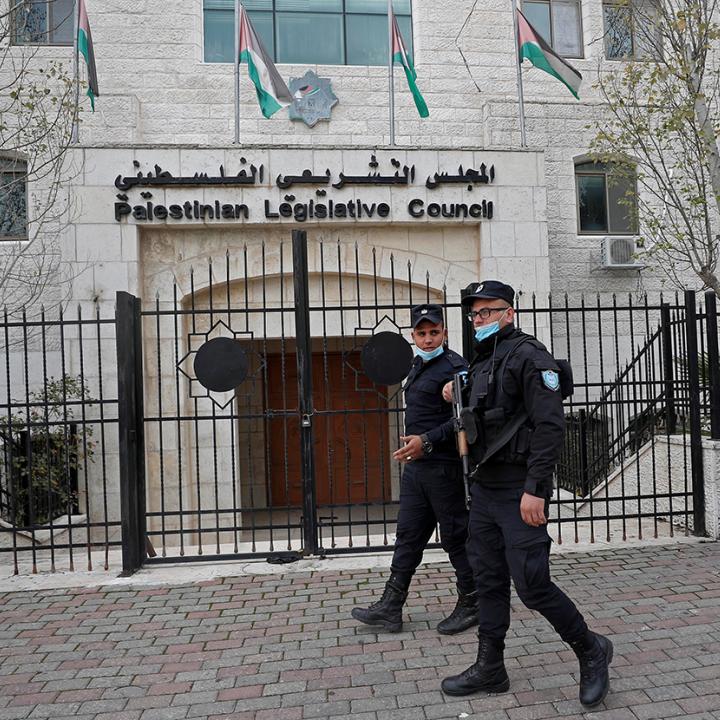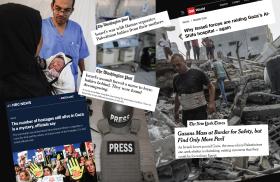
- Policy Analysis
- PolicyWatch 3822
Why a West Bank Front Has Not Opened So Far

The older generation remains skeptical of what an intifada might achieve, but Israeli crackdowns and worsening economic conditions could still ignite younger Palestinians and undermine PA security cooperation.
At a time when its military forces are focused on waging war against Hamas to the south and deterring Hezbollah to the north, Israel is relieved that the West Bank has not developed into a full-scale battleground. For a multitude of reasons, Hamas’s calls to open a second Palestinian front have gone largely unheeded so far. Yet Israeli troops are still engaged in daily operations to suppress violence in the West Bank, while the number of Palestinian fatalities continues to rise, creating a fragile situation that will require officials to keep a close eye on local security developments and the political durability of the Palestinian Authority.
The Latest Numbers
According to data from the Israel Security Agency (Shin Bet), 128 significant terrorist attacks (i.e., acts of violence that result in Israeli casualties) have been carried out in (or in some cases from) the West Bank since October 7—101 in the northern part of the territory and 27 in the southern part. The vast majority of these were shootings (112), followed by stabbings (6), vehicular attacks (4), explosions (4), and rocket fire (2).
Separate from these attacks are examples of armed combat between the Israel Defense Forces (IDF), operatives from established terrorist organizations (e.g., Hamas, Palestinian Islamic Jihad), and individuals with no organizational affiliation who formed militant battalions in their communities before or during the current war. The latter groups, most of which are found in the northern West Bank, were principally established to prevent Israel from operating against terrorist cells. Although they are not Hamas themselves, they enjoy wide popularity among West Bank youths and rely on the guidance and support of Hamas elements outside the territory for financing, weapons, and technical knowledge.
Despite the ongoing violence, the numbers reveal a significant decline in terrorist attacks over the past three weeks compared to the huge spike seen in the first three weeks after October 7, which was three times the average recorded during the same period in 2022. The IDF’s daily operations in the West Bank are having an impact on the frequency and intensity of such incidents—indeed, the killing of senior terrorists, the seizure of arms caches, the introduction of new combat patterns (e.g., aerial fire), and extensive arrests all show that Israel has “taken off the gloves” post-October. Data from the Shin Bet indicates that approximately 2,150 Palestinians have been arrested in the West Bank since October 7, a rate not seen since the second intifada (2000-2004).
Regarding casualties, the Shin Bet reports that 270 West Bank Palestinians have died in security incidents during the war, up from 182 as of mid-November. These include 123 killed while clashing with IDF units, 74 killed while participating in violent riots, 38 killed during counterterrorism raids, 28 killed accidentally, and 7 who perished during clashes with Jewish civilians, usually extremist settlers.
West Bank Palestinians appear to recognize the change in Israeli policy and are no doubt frustrated by the trap in which they find themselves. The casualties in their neighborhoods and the images of vast destruction in Gaza reinforce the local narrative that Palestinian lives are “cheap” in Israel’s eyes. Moreover, the preventive security measures taken since October 7—including a strict checkpoint policy and the total cessation of permits for 160,000 Palestinians who formerly worked in West Bank settlements or Israel—have produced a sense of “collective punishment.” Acts of violence and terrorism committed by extreme Jewish elements only exacerbate these sentiments. According to a December 10 UN report, such individuals have perpetrated around 300 instances of bodily harm and property damage since October 7. In all, at least 143 Palestinian households totaling 1,026 people have been displaced due to settler violence or access restrictions.
Hamas vs. the PA
Against this backdrop, Hamas has been trying to mobilize West Bankers—especially the younger generation—to open another front against Israel. The group sees youths as ripe for exploitation because they are more likely to identify with local militants and blame the Palestinian Authority for allowing Israel to expand its military activities in the West Bank. Statements by senior Hamas officials, media outlets, and social networks are therefore emphasizing the strategic connection between the Gaza war and the advancement of the entire Palestinian nationalist and religious agenda—not just freeing prisoners, but also ending the occupation in full and playing on the fear that Jerusalem’s al-Aqsa Mosque is somehow in danger.
The PA has been increasingly assertive as well. Before the war and during the initial days of fighting, many in the international arena saw the PA as irrelevant, but it has quickly become the essential ingredient in much postwar planning. Whether it can actually play such a role, however, will depend on its ability to resolve various tensions and contradictions.
The PA’s main concern is its negative image in the eyes of local Palestinians, most of whom dismiss it as Israel’s agent and are increasingly likely to support its archrival Hamas. According to a recent poll by Arab World for Research and Development (AWRAD) in Ramallah, 83% of West Bank respondents support Hamas’s October 7 attack and 88% believe the group is playing a positive role. The majority also support the various groups carrying out local terrorist attacks, including Hamas’s Izz al-din al-Qassam Brigades (95%), Palestinian Islamic Jihad (93%), and al-Aqsa Martyrs Brigades (87%). In contrast, most disapprove of the role played by the PA and Fatah (85% and 70%, respectively), while 57% perceive the current war as one directed against all Palestinians. Other polls by Washington Institute researchers have delved into the nuanced reasons why these sentiments exist—and why they can rapidly wax and wane with changing political and security circumstances.
In light of these views, PA president Mahmoud Abbas and senior Fatah figures have been careful to publicly condemn Israel and call on the international community to protect Palestinians. For example, in a November 29 speech, Abbas declared that the world must not stand idly by in the face of “deliberate and systematic harm to the Palestinian people,” arguing that the only way to maintain stability and regional peace is by ending the occupation and fulfilling Palestinian rights. Yet beneath this implied support for groups that actively oppose Israeli occupation, many PA officials privately hope that the IDF succeeds in smashing Hamas and killing its leaders—the only scenario in which the PA would be able to return to Gaza.
To facilitate this goal, the PA has played an increasingly vital security role throughout the West Bank in recent weeks. Its forces serve as a restraining factor, preventing the public from going out to confront Israeli troops during IDF counterterrorism operations. The PA justifies this approach by telling the public that it is protecting them from “trigger-happy” Israel.
This security cooperation could be jeopardized by the West Bank’s serious economic crisis. The PA still refuses to accept the monthly tax revenue transfers it is due because Israeli officials insist on deducting the portion normally sent to Gaza, where thousands of PA employees are still on the payroll sixteen years after Hamas’s coup. This frozen tax revenue—combined with the loss of $370 million normally injected into the West Bank economy each month by Palestinians employed in Israel and the settlements—has left the local economy in shambles. If the situation continues, the PA will be unable to pay the salaries of its 30,000 security personnel, who will then have little incentive to prevent terrorist activity against Israel.
Conclusion
The best explanation for the relative passivity of most West Bank Palestinians is the same one offered early in the war—namely, the traumatic memory of the second intifada, when they paid a huge price but failed to secure significant political achievements after four years of violence. In this respect, Israel’s recent conduct in the West Bank echoes the difficult period two decades ago when it responded to mass violence with large-scale arrests, resulting in heavy Palestinian casualties.
One could also argue that the modern influences of the past twenty years—consumer culture, social media, single-family housing, mass use of technology—have led many West Bankers to focus more on personal advancement than the collective ideologies and commitments that fuel mass uprisings. For those who lived through the second intifada, such influences could make them even more likely to prefer a distasteful status quo over their past experience of wider war, chaos, and siege.
Of course, even if this preference is prevalent in the West Bank, it is hardly set in stone, nor does it necessarily apply to younger Palestinians, who are even more prone to identifying with Hamas and other violent groups. Their aversion to the Palestinian Authority is growing, with numerous polls and analyses indicating that many locals view institutions like the PA as an unnecessary evil and an impediment to advancing the Palestinian national movement and achieving freedom from occupation.
Despite legitimate criticism of the PA’s rhetoric and conduct, however, Israelis have a crucial interest in preventing its collapse, in part so that it can continue to serve as a check on terrorists and a barrier against Hamas’s rise in the West Bank. In this sense, those who argue that there is little difference between the PA and Hamas will only ease the latter’s path to taking control of the Palestinian national movement.
Neomi Neumann is a visiting fellow at The Washington Institute and former head of the research unit at the Israel Security Agency.


